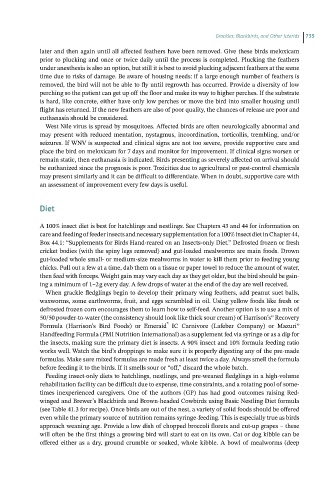Page 733 - Hand rearing birds second
P. 733
Grackles, Blackbirds, and Other Icterids 735
later and then again until all affected feathers have been removed. Give these birds meloxicam
prior to plucking and once or twice daily until the process is completed. Plucking the feathers
under anesthesia is also an option, but still it is best to avoid plucking adjacent feathers at the same
time due to risks of damage. Be aware of housing needs: if a large enough number of feathers is
removed, the bird will not be able to fly until regrowth has occurred. Provide a diversity of low
perching so the patient can get up off the floor and make its way to higher perches. If the substrate
is hard, like concrete, either have only low perches or move the bird into smaller housing until
flight has returned. If the new feathers are also of poor quality, the chances of release are poor and
euthanasia should be considered.
West Nile virus is spread by mosquitoes. Affected birds are often neurologically abnormal and
may present with reduced mentation, nystagmus, incoordination, torticollis, trembling, and/or
seizures. If WNV is suspected and clinical signs are not too severe, provide supportive care and
place the bird on meloxicam for 7 days and monitor for improvement. If clinical signs worsen or
remain static, then euthanasia is indicated. Birds presenting as severely affected on arrival should
be euthanized since the prognosis is poor. Toxicities due to agricultural or pest‐control chemicals
may present similarly and it can be difficult to differentiate. When in doubt, supportive care with
an assessment of improvement every few days is useful.
Diet
A 100% insect diet is best for hatchlings and nestlings. See Chapters 43 and 44 for information on
care and feeding of feeder insects and necessary supplementation for a 100% insect diet in Chapter 44,
Box 44.1: “Supplements for Birds Hand‐reared on an Insects‐only Diet.” Defrosted frozen or fresh
cricket bodies (with the spiny legs removed) and gut‐loaded mealworms are main foods. Drown
gut‐loaded whole small‐ or medium‐size mealworms in water to kill them prior to feeding young
chicks. Pull out a few at a time, dab them on a tissue or paper towel to reduce the amount of water,
then feed with forceps. Weight gain may vary each day as they get older, but the bird should be gain-
ing a minimum of 1–2 g every day. A few drops of water at the end of the day are well received.
When grackle fledglings begin to develop their primary wing feathers, add peanut suet balls,
waxworms, some earthworms, fruit, and eggs scrambled in oil. Using yellow foods like fresh or
defrosted frozen corn encourages them to learn how to self‐feed. Another option is to use a mix of
50/50 powder‐to‐water (the consistency should look like thick sour cream) of Harrison’s® Recovery
®
Formula (Harrison’s Bird Foods) or Emeraid IC Carnivore (Lafeber Company) or Mazuri®
Handfeeding Formula (PMI Nutrition International) as a supplement fed via syringe or as a dip for
the insects, making sure the primary diet is insects. A 90% insect and 10% formula feeding ratio
works well. Watch the bird’s droppings to make sure it is properly digesting any of the pre‐made
formulas. Make sure mixed formulas are made fresh at least twice a day. Always smell the formula
before feeding it to the birds. If it smells sour or “off,” discard the whole batch.
Feeding insect‐only diets to hatchlings, nestlings, and pre‐weaned fledglings in a high‐volume
rehabilitation facility can be difficult due to expense, time constraints, and a rotating pool of some-
times inexperienced caregivers. One of the authors (GP) has had good outcomes raising Red‐
winged and Brewer’s Blackbirds and Brown‐headed Cowbirds using Basic Nestling Diet formula
(see Table 41.3 for recipe). Once birds are out of the nest, a variety of solid foods should be offered
even while the primary source of nutrition remains syringe‐feeding. This is especially true as birds
approach weaning age. Provide a low dish of chopped broccoli florets and cut‐up grapes – these
will often be the first things a growing bird will start to eat on its own. Cat or dog kibble can be
offered either as a dry, ground crumble or soaked, whole kibble. A bowl of mealworms (deep

